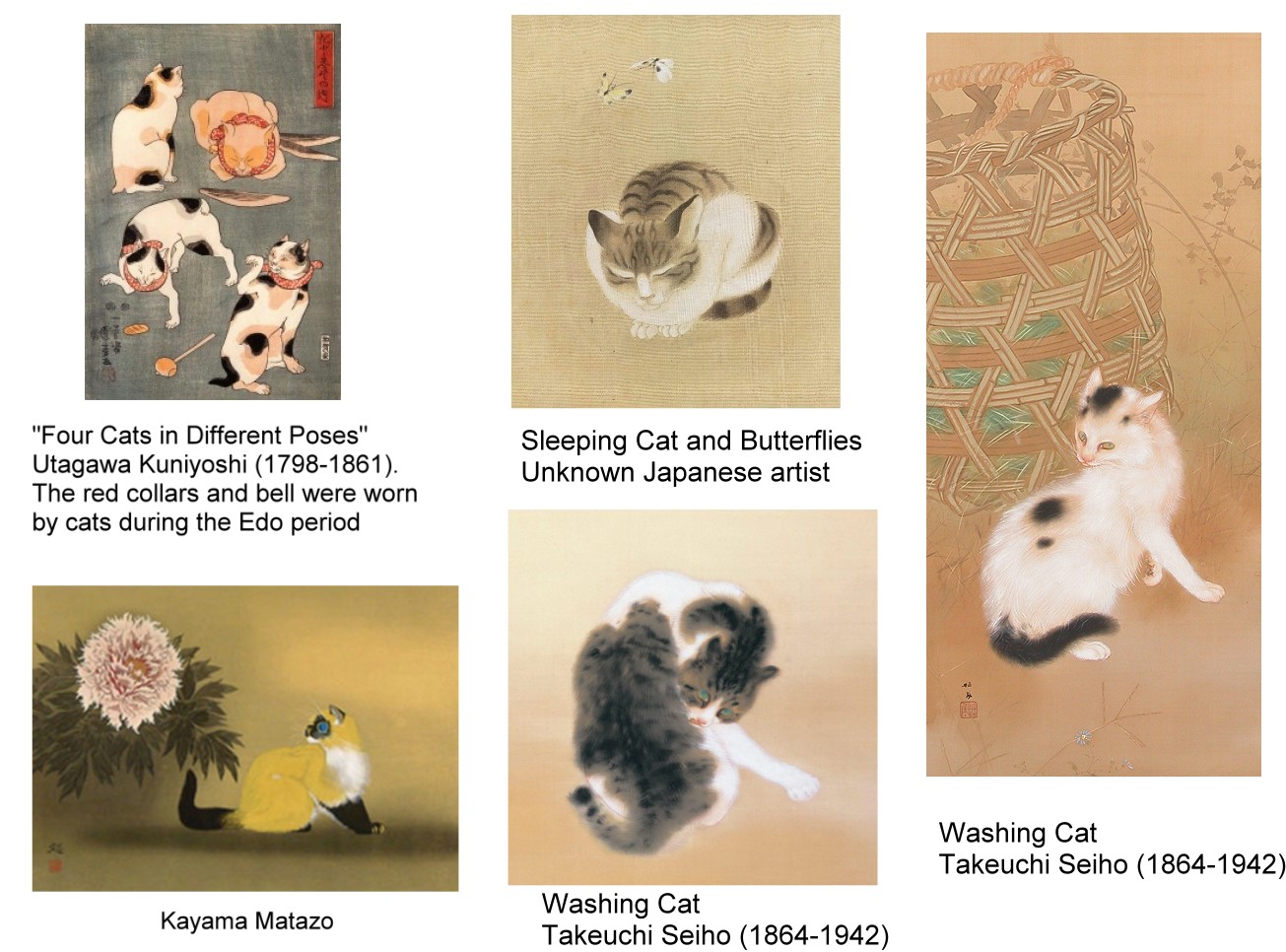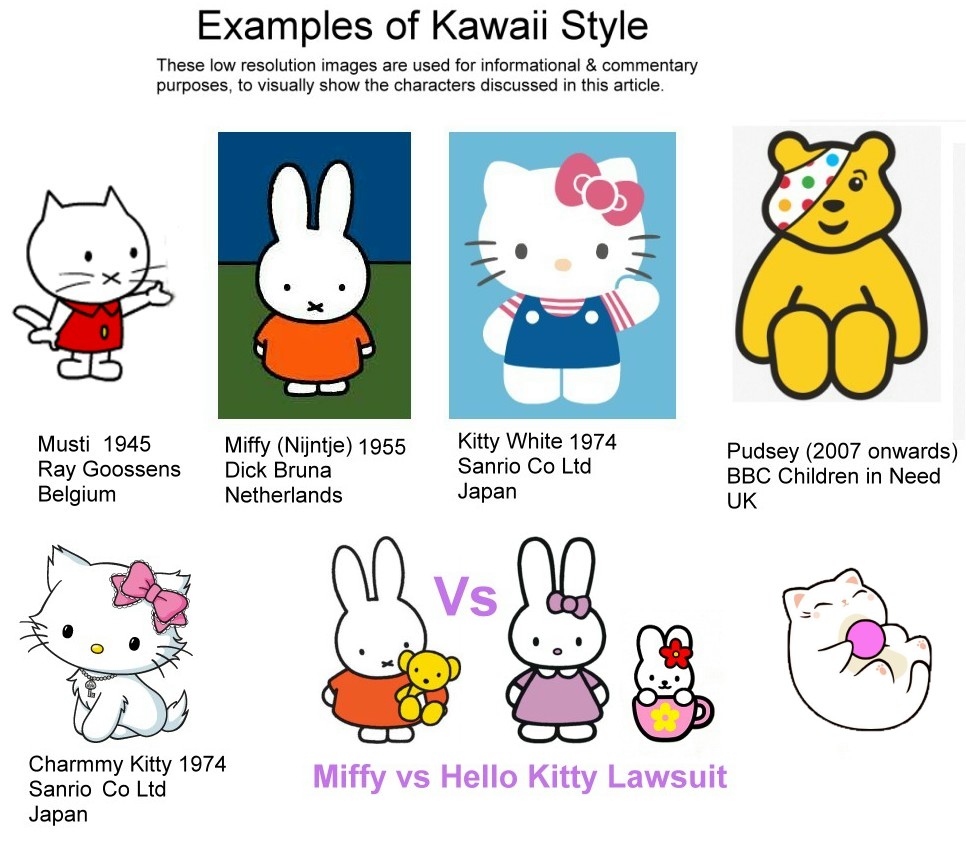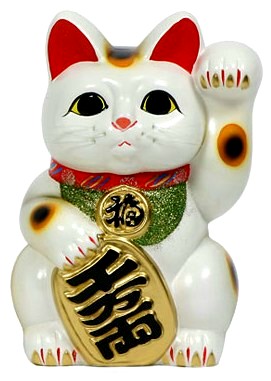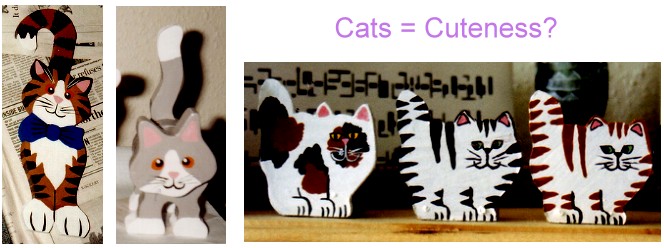
KAWAII CATS
To Westerners, the adjective “kawaii” refers to “cuteness” in relation to Japanese culture and is epitomised by “Hello Kitty”, Pokemon characters or the Dutch creation “Miffy”. Kawaii (the noun is kawaisa) also embraces the concepts of lovable, adorable, cool, non-threatening and innocent-looking. The word is derived from the kanji ideograms “ka” (acceptable) and “ai” (love). Over a few short decades, kawaii became a prominent aspect of Japanese popular culture and is found not only in entertainment, clothing, food, toys and personal appearance, but also in behaviour (high pitched voice and giggling), and mannerisms.
Cats, and especially kittens, lend themselves well to kawaii styling. Modern Persian cats are probably inherently kawaii with the exaggerated large eyes and the tiny mouth, nose and ears all set on a wide face. This gives the babyish (neotony) proportions and chubbiness that most young women seem instinctively attracted to. Cartoon cat features can be selectively diminished or exaggerated – a small-nosed wide-eyed innocent look, or a large-mouthed, small-eyed laughing look etc.
CATS IN JAPANESE ART THROUGH THE AGES
Cats (“neko” in Japanese) have been surrounded by superstitions and legends in Japan. They have been portrayed as being evil witches in disguise and, at the other end of the spectrum of bringing good fortune. These beliefs are reflected in earlier Japanese art. Cats arrived in Japan from China via Fujiwara no Sanesuke, a nobleman at the court of Emperor Ichijo, who ruled from 987 to 1011. They became popular pets among wealthy people and were known as "hand-fed tigers."
Because of their independent natures, cats seemed ungrateful, selfish and destructive; Japanese people started becoming suspicious and scared of cats. Legend had it that the cat and the serpent were the only animals that didn't cry when the Buddha died, and that the cat killed the serpent after the funeral. In spite of these, many people valued them as pets and they were valuable rodent controllers in homes and temples.
A common feline character of Japanese folklore is the supernatural “bakeneko” (monster cat that could transform itself into a huge cat or into a human, walk on its hind legs, fly, and generally menace or prey on humans. Bakeneko legends originated in the 17th century when cats were largely utilitarian and roamed free in the Japanese cities. Bakeneko had long, forked or double tails (nekomata - "forked-cat") so owners allegedly took to cutting off kittens’ tails. This appears to be a legend that explains the bobtailed mutation found in Japanese cats, where long tails are the exception rather than the norm. A bakeneko also drinks lamp-oil – this being fish-oil at the time. In other legends, though, the bakeneko is depicted as a loyal and good cats.
During the Edo period, the ukiyo-e art form became popular and bakeneko were a popular subject of ukiyo-e artists. Ukiyo-e are woodblock prints and often depicted cats doing everyday things: sleeping, chasing mice, watching fish, fascinated by butterflies, accompany their master or mistress etc. Some ukiyo-e were witty or playful e.g. Kuniyoshi’s "Cats Forming the Characters for Catfish." During the Meiji Restoration period, ukiyo-e waned in popularity as Japanese artists became influenced by Western styles. Cat paintings became more realistic and less cartoon-like.

The beckoning or lucky cat (maneki neko) is a lucky charm found in many shop windows and entrances; the raised left paw beckons shoppers to enter. This probably also had its origins during the Edo period. It may have been inspired by artfully painted women in the "pleasure quarters" beckoning men outside the "houses of amusement". These women beckoned in the traditional Japanese fashion: hand upright to show the palm and fingers folded. The maneki neko has the same pose. Another legend has it that a cat beckoned important travellers into the safety of a temple.
Black cats (kuroi-neko) are lucky in Japan, just as they are in Britain. They can cure sick children and ward off evil. White cats (shiroi-neko) are symbols of purity. Meneki neko figurines can be found in both black and white. Nowadays they are also common in a gold colour or the lucky “mi-ke” (tortie-and-white) pattern. The sleeping cat (nemuri-neko) is attributed to the artist Hidari Jingoro who became so fascinated with cats that he spent eight months in seclusion, perfecting his feline sculptures and carvings. The ultimate result, and most influential of his sculptures, was the nemuri-neko.
“Doraemon” is a robotic cat from the future; it first appeared in a manga series in 1969 and spread to TV in 1973 and 1979. Cats are well represented in anime, especially in that directed by Hayao Miyazaki e.g. "Kiki's Delivery Service" (the black cat belonging to a young witch) and "My Neighbour Totoro" (Catbus - a giant tabby cat that is a real live bus, with furry seats, who leaps across the countryside). Hiroyuki Morita directed “The Cat Returns” where Haru saves a cat from being run over on her way back from school, little realising that the cat is Lune, the son of the Cat King. Haru is invited to visit the Cat King's kingdom where she meets cranky fat cat Muta and the Cat Bureau.
Catgirls are popular in anime, manga and video games. These are girls or young women that grow cat ears and tails, etc and whose speech is littered with the sound “nya” (meow). The bakeneko character has also been reimagined in anime and manga.
KAWAII STYLE
The original definition of kawaii came from Lady Murasaki's “The Tale of Genji” and referred to pitiable qualities. It later became associated with feminine qualities such as docility. According to Soichi Masubuchi’s “Kawaii Syndrome”, the kawaii is supplanting the Japanese aesthetics of "beautiful" and "refined" found in earlier art and drawings (though some earlier art is also cartoon-like). At the same time it preserves certain minimalist and “harmonious” qualities. Kawaii is increasingly a part of Japanese national identity and possibly related to a harmony-loving culture because it is associated with being non-threatening and with innocence. The less innocent side is that men seem attracted to women who resemble schoolgirls and adult women adopt a wide-eyed “cute” look, sometimes to the point of having eyelid surgery (to make their eyes appear larger), dental veneers (to imitate the overcrowded look of an adolescent’s teeth) or wearing child-like clothing with lace, bows and ribbons.
Kawaii is now found everywhere in Japan, from Hello Kitty accessories to cute company or government mascots and even a cartoon writing style called koneko ji, meaning "kitten writing". It has also become popular among young anime fans in the West and among subcultures that are influenced by the Japanese culture.
The best known Kawaii cat is “Hello Kitty” (full name Kitty White) aka Kitty Chan, created by Yuko Shimizu for the Japanese company Sanrio in 1974 and exported to the USA in 1976. Kitty is a female white Japanese Bobtail with a red bow beside her left ear. Usually associated with the colour pink, she was aimed at pre-adolescent girls, but has a big adult following and appears on products as diverse as purses, laptops and cars. Since 2007, Hello Kitty designs evolved to include less pink and more black, and to be less kawaii to appeal to the adult consumers.

Hello Kitty originally referred to a family of cats with the perky and kind-hearted Kitty White as a central character. She had a shy twin sister, Mimmy, who wore a yellow bow by her right ear. The family included Papa George, Mama Mary, Grandpa Anthony and Grandma Margaret. Kitty’s best friend is Dear Daniel (Daniel Starr) and Kitty has a pet white Persian cat called Charmmy Kitty. The whole family is British and live in London. Hello Kitty is also reminiscent of the traditional Maneki Neko beckoning cats.

In interviews, Dutch artist Dick Bruna, creator of Miffy (Dutch: Nijntje) has said that Hello Kitty is a copy of Miffy (created 1955) being rendered in a similar style rather than being original. In 2010, Bruna sued Sanrio over one of Hello Kitty's companions, a Miffy-like rabbit named Cathy. A Dutch court ruled against Sanrio, and eventually reached an out-of-court settlement requiring Sanrio to stop producing merchandise that featured Cathy. The Belgian cartoon cat “Musti”, created by Ray Goossens, has also been suggested as the inspiration for both Miffy and Hello Kitty. Whether or not the infringement was intentional, I can see how it is difficult to appear different when a character’s features are extremely simplified (hence the frequent use of bows, flowers and outfits in kawaii characters).
